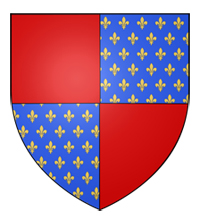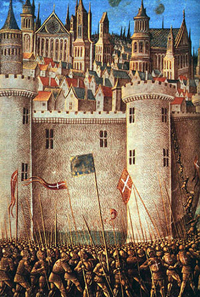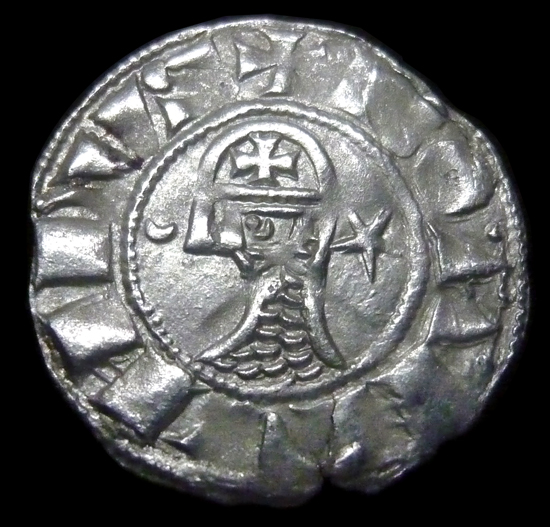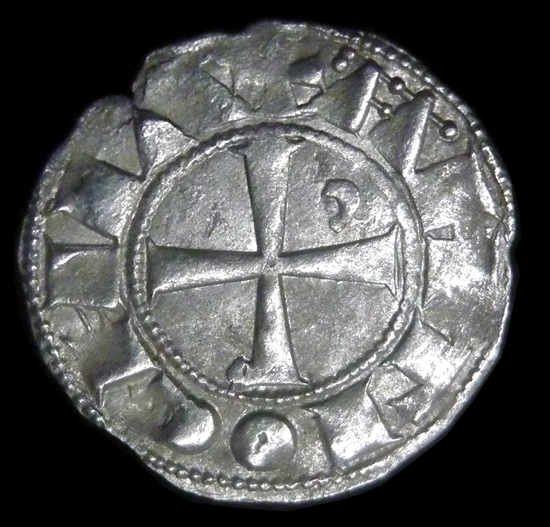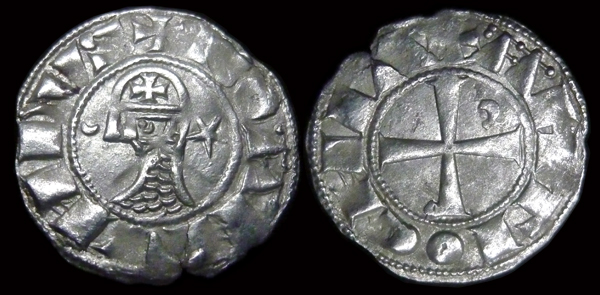
Denier - PRINCE BOHEMOND III
Born: 1148 (est)
Prince: A.D. 1163-1201
Obverse: Portrait helmeted head right with crescent moon to left and star to right - BOAMVNDVS
Reverse: Cross with crescent moon top right of cross (Five pellets on A) - ANTIOCHIA
|
This coin was minted for the Principality of Antioch, a state established during the first crusade that was at various times, and for most of its history, a vassal to Constantinople, The Kingdom of Jerusalem, or the Kingdom of Armenia before being conquered by Muslim forces under Baibars, the Mamluk Sultan of Egypt. The coin and its distinctive abstract portrait of a crusader knight was minted and issued during the reign of Bohemond III, prince of Antioch from 1163 to 1201 AD. The Principality of Antioch was founded in 1098 by Bohemond of Toranto (Bohemond I), an Italian crusader prince who led a Christian army in a siege of the Syrian city of Antioch held at the time by Seljuk Turks. The once great city had been in steady decline for more than 300 years since it found itself on the front lines of the wars between Muslim and Christian rulers. During this time the city would change hands several times. It was in the possession of the Sultanate of Rum who had only held the city for 14 years by the time of the crusaders arrival. After a long and grueling siege of the city which boasted formidable defenses, Bohemond gained entry to the city and captured it only to be forced to immediately defend it against relief forces sent by the Sultan of Mosul. The crusaders defeated the relief force and, after some dispute over who would control the city, Bohemond declared himself Prince of Antioch and the rest of the crusaders moved on to Jerusalem. Bohemond had, like most crusaders, promised the emperor of Constantinople to return all lands recaptured from the Muslims. He instead kept Antioch for himself and looked to expand his holdings through further conquest of Muslim and Byzantine lands further angering the Byzantine emperor. Instead of aid from the west, the crusaders had proven to be far less altruistic and in some cases as troublesome as the Muslims they had come to help defend against. In the end, Bohemond chose to go to war against Constantinople and was soundly defeated by forces under the Emperor Alexius who forced Bohemond to accept a humiliating defeat which made him a vassal to Constantinople. By all accounts Bohemond I was a broken man and died six months later leaving Antioch in the hands of several regents who ruled in the name of his young son, Bohemond II. Just three years old at the time of his father's death, Bohemond II would take control of the principality upon coming of age. Bohemond II married Alice, the daughter of Baldwin II king of Jerusalem, who gave birth to a daughter, Constance of Antioch. In 1130 Bohemond was killed in battle and Antioch was handed down to Constance, then four years old. Constance would rule under the disputed regency of the Kings of Jerusalem and her mother Alice who vied for control of the principality. At just ten years of age, Constance was married to Raymond of Poitiers who ruled as the Prince of Antioch from 1136 until his death in 1149 at the hands of Nur Ad-Din Zangi. Bohemond III was the son of Raymond and Constance. Born in 1144 he was just five years old when his father died. Constance married Raynald of Chatillon, a man generally typified by contemporary sources as a loose cannon. Raynald ruled as prince until his capture and subsequent seventeen year imprisonment for plundering Muslim lands in 1160 leaving Constance as regent. By this time Bohemond III was fifteen and was legally able to rule but Constance attempted to block his accession and retain sole rule of the principality. King Baldwin III of Jerusalem intervened and declared Bohemond III ruler of Antioch. Constance asked for aid from the Armenian Kingdom of Cilicia in 1163 but was instead forced into exile and died later that year allowing Bohemond to take full and undisputed control of the principality. The following year Bohemond III and Raymond III of Tripoli moved to aid the city of Harim. Harim was a strategically important city that had changed hands between Muslim and Christian several times. It had been in Crusader control since 1158 but was again being threatened by Seljuk Turk forces under Nur ad-Din Zengi. The crusader force attempted to break the siege of the city but was soundly defeated at the Battle of Harim. Harim fell and both Bohemond and Raymond were captured. They were released the following year for a ransom of 150,000 dinars arranged by the emperor at Constantinople, Manuel I and Amalric I of Jerusalem who also served as regent for Antioch during his captivity. Mleh of Armenia, a Templar turned Muslim, entered into an alliance with Nur ad-Din Zengi prompting and invasion of Armenia in 1172. With blessing and aid from the Emperor, Bohemond III and Raymond III were joined by Philip, the Count of Flanders, in failed assault to reclaim the city of Harim in 1177. The Emperor Manuel wanted more direct control over Antioch. He was married to Bohemond's sister so he was not only his nominal overlord but his brother in law as well. Bohemond agreed to re-install a Greek Patriarch, Athanasius II, in Antioch angering Latin Patriarch Aimery of Lemoges. Bohemond would further tie himself to the Emperor by marrying his niece, Theodora Komnene, around 1176. To marry Theodora, Bohemond probably divorced his first wife, Orguilleuse d'Harenc, mother of his two eldest sons Raymond and Bohemond IV. In 1180 Bohemond and Raymond III of Tripoli looked to install an ally, Baldwin of Ibelin, as King of Jerusalem. The troubled kingdom had enemies and was ruled by Baldwin IV, a childless leper. Without an heir and in poor health he searched for a suitable person who could marry his sister Sibylla. Sibylla's son from her first marriage, Baldwin V, would become nominal king upon his death and would need a regent. Bohemond III and Raymond III entered Jerusalem in force to assert their claims but Sibylla instead married Guy of Lusignan, a prominent and well-connected knight in her brothers service. It is unknown whether Baldwin approved of this marriage but he did not take steps to reverse it. On the death of Baldwin IV in 1185, and the death of his successor, Sibylla's son Baldwin V, soon after, Guy was made King by Sibylla who handed him her crown. An attempted coup failed to materialize leaving Guy on the throne. Guy and Sibylla’s rule would prove disastrous. In just two years Guy would face humiliating defeat at the Battle of Hattin and Jerusalem would fall to Saladin, Sultan of Egypt and Syria and founder of the Ayyubid Dynasty. Bohemond III divorced Theodora shortly after her uncle's death and married Sibylle de Burzey. This marriage was strongly contested by the clergy who claimed the woman was wicked. Bohemond could not be deterred from the marraige. He imprisoned or banished church leaders and nobles who opposed him and confiscated their property. He was excommunicated by Pope Alexander III but still refused all attempts to mediate the situation.
Bohemond negotiated a peace treaty with Saladin who had been harassing Antioch in 1183. He then took steps to consolidate and strengthen Antioch's defenses. Guy of Jerusalem instead engaged Saladin and suffered a disastrous defeat at the Battle of Hattin in 1187, Jerusalem would fall soon after. Raymond III of Tripoli and Bohemond's eldest son Raymond fought in the battle but escaped. Saladin then invaded Antioch but Bohemond was able to mount a successful defense. Bohemond's eldest son Raymond was made Count of Tripoli on the death of his godfather, Raymond III, shortly after the Battle of Hattin. He ruled Tripoli as Raymond IV but after only two years he was recalled by his father who wanted his eldest son and heir at his court. Raymond was replaced as Count of Tripoli by his younger brother, Bohemond IV. In 1194 Leo II of Armenia took the castle of Bagras from Saladin who had previously taken it from Bohemond and the Knights Templar who now demanded it be returned to them. Bohemond was led to believe that Leo wished to negotiate but when Bohemond came to meet with him, Leo instead captured and imprisoned Bohemond who was released only after he relinquished all claims to Armenian lands. Bohemond further allied himself with Leo by marrying his son Raymond to Leo's niece Alice in 1195. Raymond died in 1199 leaving an heir, Raymond-Roupen, his son by Alice. When Bohemond III died in 1201 the succession was disputed between his second son, Bohemond IV, and Raymond-Roupen, his grandson through Raymond. Bohemond IV initially prevailed but the issue came to blows and Raymon-Roupen, with help from his uncle Leo II of Armenia, took Antioch in 1216. Raymon-Roupen's reign would be short lived as Bohemond IV was able to retake Antioch three years later. Bohemond IV would rule both Antioch and Tripoli while Raymond-Roupen would die trying to claim the throne of Armenia. More about the ancient city of Antioch: The history of the city of Antioch long predates the crusades, Islam, and Christianity. It is an ancient city founded by Seleucus I Nicator, a general of Alexander the Great, around the end of the 4th century BC. Upon the death of Alexander, his generals fought over his vast empire. After winning much of Alexander's expansive eastern conquests, he established the Seleucid Empire and Dynasty that would last about 250 years. Like most of Alexander's generals turned kings, Seleucus founded many new cities naming them after his family, one of which was Antioch on the banks of the Orontes River. The city was named for his father Antiochus, a general who served under Alexander's father, Philip II of Macedon. With an ideal location Antioch would serve as the capital of the empire for most of its existence except for the first 65 years when the City of Seleucia on the Tigris was the seat of power. At its founding Antioch had around 20-25,000 inhabitants including Macedonians, Jews, and the population of Antigonia, a nearby city whose inhabitants were relocated to Antioch. Successive Seleucid rulers would build new districts and by the reign of Antiochus IV Epiphanes (174-164 BC) there were four distinct quarters thus the city became known as Tetrapolis. At its height in the late Hellenistic, early Roman periods, Antioch's population possibly exceeded 500,000 (excluding slaves) and was the third largest city in the world. Ideally situated on the Orontes River with the town of Seleucia Pieria as its port on the Mediterranean sea, Antioch quickly became a major commercial and cultural center in the near east. Eventually vassal states sought independence, civil wars broke out and the empire fragmented as internal factions fought for supremacy. Wars with Parthia and Seleucid attempts to expand into Greece brought it into direct conflict with the growing power of Rome. All of the post Alexander Hellenistic states, including the Seleucid Empire, would fall in turn. By 100 BC the Seleucid Empire had deteriorated to include just Antioch and a few other Syrian cities. Because of its importance, Antioch's fortunes were not tied to the fate of the Seleucid Empire as evidenced by the fact that the city was still growing and as prosperous as ever even as the empire around it fell. The citizens of Antioch were not shy in showing its displeasure for its weak rulers. In 83 BC, Antioch invited Tigranes of Armenia to become its protector. Tigranes occupied Antioch effectively putting an end to Seleucid rule. Not long after, Tigranes himself would lose a series of conflicts with Rome ending in his surrender to Pompey. Rome appointed Antiochus XIII as a client ruler of a puppet state but deposed and killed him soon after. By 64 BC Antioch was the capital of Roman Syria and was granted the status of civitas libera or 'free state'. Roman Rule: Antioch would continue to prosper under Roman rule and would be favored by most emperors who would regularly bestow gifts and favors. The city would effectively become the capitol of the empire's eastern states replacing the more remote Alexandria. Julius Caesar visited the city in 47 BC and confirmed its status as a free city state under the protection of Rome. They would be rewarded a temple to Jupiter Capitolinus, probably by Octavian (Augustus) as well as a forum in the Roman style. The city's theater would be expanded and improved by different emperors through the first and second century. The great Roman general Agrippa favored the city and its theater as did Tiberius who also bestowed upon the city long colonnades. The Emperor Trajan was visiting Antioch when it was damaged by an earthquake, he took shelter in the circus and later helped repair the city and finished the work on the now quite grand theater. It is the city where the beloved general Germanicus died in 19 AD and under the emperor Commodus it became the host of popular Olympic Games. The religious atmosphere of the city was quite diverse. Antioch was home, at one point, to most religions of any given time period. It was also home to a sizable Jewish population since its founding. It played a significant role in the rise of Christianity becoming home to a large Christian population. It was the site of a very early church, possibly founded by Peter who is considered its first bishop. It was the location of the so called 'Incident of Antioch', a disagreement between the Apostles Peter and Paul and is thought to be where the Gospel of Matthew may have been written. The city is well known for having drawn the ire of the emperor Julian who visited the city in 362 AD. His visit did not go well as what he had expected to be a great city that rivaled Constantinople did not live up to his expectations. The city was suffering from a shortage of food and was no longer able to support itself as was generally expected of an imperial city. Julian blamed this on corruption and irresponsibility by the leading citizens. He was also very disappointed in the state of the pagan temples and the lack of attendance to the Gods as opposed to the healthy Christian population and their zeal for their own God. This disappointment was mutual as Julian's own actions did little to endear the population to him. The root cause of this clash was the very basic differences between the cosmopolitan and diverse Syrian population of the city and the very stoic and conservative Neo-Platonist emperor. He was not what the Antiochenes thought an emperor should be in his plain dress and his unkempt beard. They were unimpressed by his appearance and demeanor and saw the austere emperor as a bore. Julian in turn saw the people of Antioch as a corrupt population given over to pleasures, frivolity, extravagance and lacking the proper sober austerity and reverence for the Gods. When the people of Antioch publicly criticized and lampooned him, he answered them with a satire of himself called the Misopogon (Beard Hater). Although it was supposed to be a satire of himself, it was mostly a defense of his austere way of life and a rather harsh indictment of the character of the people of Antioch. He traced their flawed character back to the cities namesake and its founder, as if it were not their fault as they were born this way and had no good examples to emulate in their own history. Luckily for the people of Antioch, Julian would leave the city to campaign again Persia and was killed soon after. His successors would again view Antioch favorably and they would again be the recipient of their favors such as the new public works endowed to the city by Emperor Valens. The Emperor Theodosius, however, deprived the city of its metropolitan status because of their vocal objections to new taxes imposed by that emperor. Antioch was severely damaged by a devastating earthquake in 526. It was later renamed Theopolis (City of God) by Justinian I who also looked to repair and restore the damaged city. This work was all but negated when the city was sacked and burned by the Persian Emperor Khosrau I in 538. The population of the city sharply declined and even though Justinian sought to again repair and rebuild the city, it would never again be the great metropolis it once was. In 637 the city was just one of many conquered by Arab forces under the caliphate of al-Rashidun (the rightly guided caliphs) during the initial rise and expansion of Islam. Under Arab rule the city was renamed Antakiyyah and found itself on the front lines of the wars between two hostile empires for the next 350 years helping along the city's rapid deterioration and decline. It would again be recaptured by the Eastern Empire in 969 only to be lost to the Seljuk Turks 1084. The sultanate of Rum would hold it for only fourteen years until the arrival of Crusaders who conquered the city in 1098. After 170 years of tumultuous crusader rule, Bohemond VI, great grandson of Bohemond III, lost Antioch to Muslim forces under Baibars, the Mamluk Sultan of Egypt in 1268. Antioch would be sacked and burned and all of northern Syria would soon be lost. With the loss of the last crusader stronghold of Acre twenty three years later, the Crusaders States would cease to exist. Antioch would continue to exist in a much diminished state for the next 160 as it rather quickly declined. By 1432 much of the population had relocated and the city was virtually deserted and left to ruin. There is very little left of the once great city as today it lies buried and in ruin save for some of its once great walls. Much of the ancient city lies beneath the ever expanding modern city Antakya making excavation difficult or impossible. Attempts to find and uncover the ancient city began in 1932 but failed to locate much of the great structures known to have existed. Only recently, as the land is reclaimed by the expanding modern city, construction has begun to uncover more and more evidence of the old city that was once one of the greatest cities in the world. |

